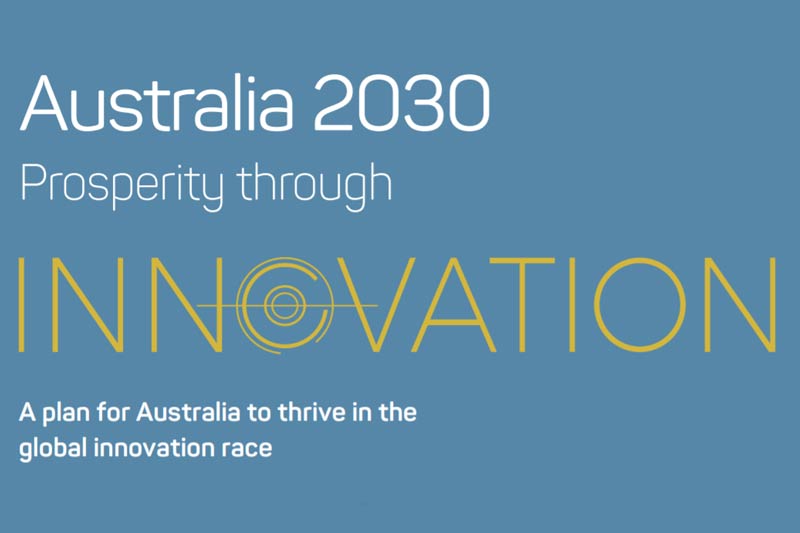
Last week, Innovation and Science Australia (ISA) released
a strategic plan for the Australian innovation, science and research system out
to 2030. Australia
2030: Prosperity through Innovation (the 2030 Plan) aims to
contribute to the wellbeing and prosperity of all Australians by strengthening
Australia's innovation performance to become a leading innovation nation.
The Australian Government
launched the National Innovation and Science Agenda (NISA) in 2015. It created
a long-term, strategic investment framework by establishing ISA with an
independent and expert board. ISA was tasked with undertaking a performance
review of Australia’s innovation system, and developing a strategic plan to
2030 advising policy makers on how to optimise investment in Australian
innovation.
The Plan provides a national
roadmap for government to accelerate Australian innovation and achieve ISA’s
vision for 2030 which aims to leverage Australia’s strengths in innovation, science and research will benefit all
Australians through 1) strong economic growth; 2) competitive industries and
companies, and collaborative education and knowledge institutions; 3) plentiful
jobs that are meaningful and productive; and 4) a fair and inclusive society
with a high quality of life.
According to the plan document, by 2030 a shortage of workers is a more
likely problem than a shortage of jobs due to automation. A McKinsey report estimated that Australia’s ageing
population will create a 6 per cent shortfall in the number of
workers needed to maintain current gross domestic product (GDP) growth in 2030.
In this scenario, innovation and digital technologies such as automation will
help fill Australia’s future labour gap, by improving productivity and
performing tasks workers do not want, or need, to do.
In addition, the types of jobs available, the skills needed to do them,
and the length of employment will change.
To benefit from future opportunities, Australia will have to be one of
the best places in the world in which to undertake innovation, science and research.
As part of the 2030 strategy, ISA has identified five imperatives for
action across the innovation system in Australia:
- Education: Respond to the changing nature of
work by equipping all Australians with skills relevant to 2030 - Industry: Ensure Australia’s ongoing
prosperity by stimulating high-growth firms and improving productivity - Government: Become a catalyst for innovation
and be recognised as a global leader in innovative service delivery - Research & development: Improve research
and development effectiveness by increasing translation and commercialisation
of research - Culture & ambition: Enhance the national culture of innovation by
launching ambitious National Missions
Within education, the Plan recommends
improving the teaching of science, technology, engineering and mathematics and
21st-century skills through development for teachers and school leaders. Other
areas of focus include reducing education inequality through targeted
interventions and making Australia’s vocational educational and training system
more responsive to new priorities.
For the industry, the Plan talks about better
targeting the Research
and Development Tax Incentive program, and increasing support for direct
grant programs that target national priorities. Industry–research sector
collaboration could be increased by introducing a collaboration premium in the
Research and Development Tax Incentive program.
The Export Market Development Grants funding
can be used to support the growth of export firms, particularly young
high-growth firms, by expanding and making better use of trade agreements. Australia’s
digital economy can be strengthened to capture opportunities presented by the
Internet. (Last year, the Australian Government announced that
it will develop a national
Digital Economy Strategy, in consultation with industry, thought-leaders,
small and medium sized businesses, government, community as well as the broader
private sector.)
In addition, access to global talent can be
improved through flexibility in skilled immigration rules, and increasing the
profile of Australia as an attractive destination for business builders.
The government has to ensure a flexible
regulatory environment that supports innovation. The Plan also recommends
accelerating the use of open data by improving access and usefulness and using government
procurement as a strategic lever to stimulate innovation.
Within the R&D area, there is scope to
increase institutional support for commercialisation by establishing a
dedicated stream of funding for translational activities. Maintaining Australia’s
high-quality research will require continued investment in national research
infrastructure, commencing with the nation’s high-performance computing
facilities.
The plan proposes a Genomics and Precision
Medicine National Mission as an ideal ambitious first mission. According to
ISA, the development of a robust framework to identify and implement missions can
help ensure that Australia’s National Missions are effective.
Read the complete report here.
















